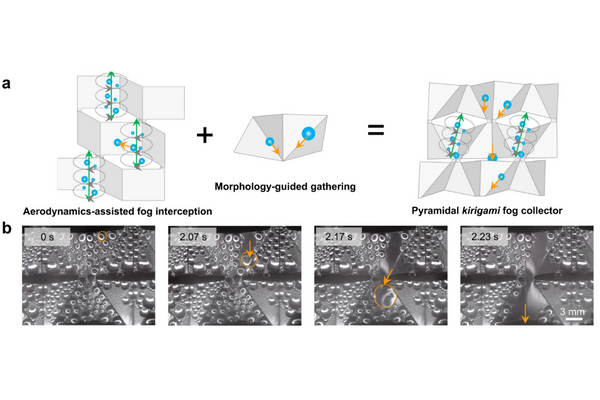
Original Article Written by Melissa Pappas. Read the Original article here!
Climate change is forcing us to reshape our relationship with water. In some places, shifts in weather patterns cause droughts and in others, floods. Collecting atmospheric water could help us adapt to both severe dry spells and inundating amounts of precipitation by providing a source of freshwater or dehumidifying humid places.
Current devices that remove water from the air are not efficient on a large scale. The natural drag from wind currents deflects water droplets around the device instead of intercepting and collecting them. The current solution is to fabricate micro- and nanotextures on their surfaces or use lubricants to attract water and facilitate its collection. These solutions are costly and sacrifice the design’s resiliency and robustness. Providing a solution to the lack of freshwater, the need for air conditioning and dehumidification, and the urgency of carbon emission reductions requires a change to the design of current moisture collection and removal devices.
Penn engineers have created such a device utilizing the geometry of simple materials to collect atmospheric water without an external energy source. The device itself seems as simple as a transparent plastic screen, but upon closer look, it is made up of three-dimensional pyramid structures. These pyramid structures are highly efficient at pulling water from the environment due to the interaction of air flow over their precise geometry.
Shu Yang, Joseph Bordogna Professor in Materials Science and Engineering and Chemical and Biomolecular Engineering, and Paulo Arratia, Professor in Mechanical Engineering and Applied Mechanics and Chemical and Biomolecular Engineering, have created these innovative water collecting devices through simple structures made of cuts and folds.
“Kirigami is the cousin to origami,” says Yang. “While origami is the folding of paper or materials to make a three-dimensional structure, kirigami is cutting and folding of materials, an ancient art from China and Japan. Artists, architects, mathematicians, and now engineers are using this technique to create new problem-solving designs.”
In an effort to decarbonize our country’s industry sector, one of the largest contributors to US greenhouse gas emissions, the DOE is dedicating $57.9 million to 30 research projects. Yang is part of the multi-university team who will work on one of those projects focusing on creating an efficient, water collecting heat pump to dry out wood. The project, with $2.2 million in funding, aims to use these kirigami water collecting devices to decrease the energy requirement of the wood desiccation process by 25% as well as reducing operating costs.
Yang and Arratia’s study, published in Nature Communications, describes how their kirigami water collecting devices work.
“We created these water collectors with cut edges and a given geometry before we understood their ability to capture water much more efficiently than traditional designs,” says Yang.
After observing a surprisingly high amount of water collected from one of these kirigami water capturers, Jing Li, first author and postdoc in Yang’s lab, started investigating the aerodynamics created by the design itself.
“We characterized the wind movement around the device in action and found that the shape of the structure was actually manipulating air movement in a way that funneled water droplets into the collector,” says Li.

The geometry creates miniature wind vortices (like tornados) that increase water droplet capture without any expensive nanostructured coatings. The design simplifies the mechanism of collecting water droplets from fog. It also removes the complex manufacturing process of traditional devices.
“Our results show a 16.1% efficiency which translates to over 20 liters of water collected per square meter per hour,” says Li. “Previous devices that use specialized coatings for increased efficiency have only 5-10% efficiency.”
After successful experimentation, Yang and Arratia envision feasible locations for device deployment.
“There are many places in need of freshwater that have little precipitation but high fog cover,” says Yang. “For example, California, Brazil and tropical areas are locations where we will want to deploy larger kirigami water collectors.”
“I grew up in Brazil,” says Arratia. “I saw the need for freshwater even back then. This technology would help my hometown. I also see so many applications that will help bring freshwater to other parts of the world. For example, in places where desalinated seawater is used as a freshwater source, our water collectors can be used to capture the water in the steam generated by the desalination process, conserving additional water and energy.”
“In addition to locations that need freshwater, there are areas that are dealing with high humidity,” says Yang. “In those locations, including Philadelphia, buildings require dehumidifiers, and kirigami water collectors can be used to collect as much moisture from the air as possible to decrease the energetic costs of dehumidification. This ability is what extends the use of these devices to wood desiccation, a common need for industry processes that require heat exchange. Now, our devices can make that process more eco-friendly, and we are excited to be working on this next step with the funding from the DOE.”
